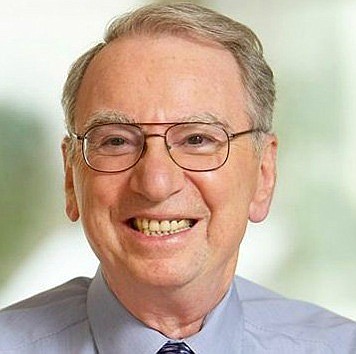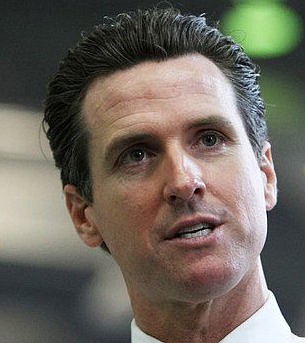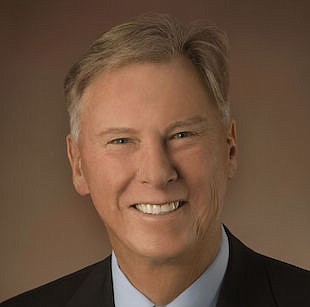 Facebook
Facebook
 X
X
 Instagram
Instagram
 TikTok
TikTok
 Youtube
Youtube

On March 17, Republican San Diego mayor Kevin Faulconer — in the midst of a record money-raising drive to fund his June reelection bid — slipped away from city hall to make an unheralded trip to La Jolla.
The mayor was bound for a sit-down with Qualcomm cofounder Irwin Jacobs about reviving the Democratic billionaire's dormant Balboa Park parking and road makeover plan.

"Mayor Faulconer would like to meet with Dr. Irwin Jacobs regarding Plaza de Panama in the next few weeks," Faulconer's scheduler Michelle Porras had written in a February 29 email to Kaye Burlingame, Jacobs's personal executive assistant.
"Irwin would like to meet here at his home office," wrote Burlingame in a March 1 reply.
Two days later, Faulconer’s executive assistant Tanya Lundy emailed Burlingame with final details. "Thank you for providing Dr. Jacobs’ availability to meet with Mayor Faulconer regarding Plaza de Panama. We are pleased to confirm Thursday, March 17, 4:00 p.m., at Dr. Jacobs’ home office. Accompanying the Mayor will be Katherine Johnston, Director of Infrastructure and Budget Policy."
Thus was born the private summit that has led to the rebooting of Jacobs's controversial effort to bulldoze new roads and build a mammoth parking structure in the heart of the park, taking out an 82-foot swath of the historic Cabrillo Bridge in the process.
According to city campaign disclosure filings, the mayor's agreement to back the giant Jacobs park project did not go unrewarded.
On March 9, six days after the meeting between Faulconer and Jacobs was set up, four Qualcomm executives — Christine Trimble, Christine Thoene, Daniel Torpey, and William Maheu — each wrote checks to the Faulconer campaign, totaling $1300.
On March 13, $1050 flowed into the mayor's coffers from Qualcomm human resources executive vice president Michelle Stirling, who lives in Poway.
And in the days following the mayor's March 17 meet-up with the billionaire, more Qualcomm money arrived in the form of $250 on March 29 from Monique Richardson of the company's government relations department. On March 31, Paul Jacobs, son of Irwin, and Qualcomm's executive chairman and chairman of the board, gave $1000.
One day later, on April 1, Qualcomm executive vice president and general counsel Donald Rosenberg contributed $1000 and the company's senior director of public affairs Molly Gavin gave $500. In addition, the firm's August 1, 2016, lobbying disclosure filing shows, senior vice president of government affairs William Bold kicked in $1050 on April 28.
Besides their well-timed political spending spree, executives at Qualcomm threw a November 17 fundraiser for the mayor last year, coming up with $9275 for the Faulconer cause, according to a company lobbying disclosure.
Records released by the city following a request under the California Public Records Act show that Faulconer's office has been in discussion with Jacobs regarding Balboa Park since at least November of last year, although the billionaire’s revived bulldozing plan was made public only after the mayor was safely reelected this June.
"As a follow up to our November meeting and my previous written correspondence, I am sharing the existing City practices and policies that currently guide donor recognition within Balboa Park," wrote the mayor's director of infrastructure and budget policy Katherine Johnston to Jacobs in a four-page letter dated December 24, 2015.
"Recognition of significant financial or civic contributions at City facilities is valuable in fostering the development of public/private partnerships critical to building a stronger and more vibrant San Diego."
Added the letter, "The most recent example of a City facility being named in honor of an individual was in 2009 when the Park and Recreation Board voted to approve the naming of 'Craig Noel Circle' in the Plaza de Panama area. The proposal was to name the traffic circle within the Plaza de Panama and place a commemorative plaque in the Plaza."
On June 30 of this year, the day of the public announcement of the revived Jacobs plan, mayoral deputy chief of staff Matt Awbrey emailed Jacobs a copy of Faulconer's news release announcing the mayor's revival of the Balboa Park project. “Hello Dr. Jacobs, As promised, below is the final news release. We sincerely appreciate your ongoing support and look forward to the next steps. We will be in touch.” According to Faulconer’s official calendar, the mayor and Jacobs had met in the mayor’s office two days earlier.

No strangers to giving cash and getting political influence, Jacobs and his wife came up with $12,000 for the 2014 reelection campaign of Democratic Lt Gov. Gavin Newsom.
Just two weeks earlier, the Democrat authored a letter blasting then-state historic officer Wayne Donaldson for criticizing the billionaire's Balboa Park makeover, including the called-for "demolition of 82 feet of the Cabrillo Bridge" and earth-filling of "significant parts of Palm Canyon, altering the historic space and land forms irreversibly."

Following the Jacobs contributions and the Newsom dust-up, Donaldson lost his job.
Qualcomm itself has long been the target of critics who have accused the firm of using cash and influence over high-dollar employees to funnel political support to causes it favors, including expanding the controversial H-1B visa program to admit more foreign engineers to this country.
In January 2013, the company was hit with a disclosure lawsuit by New York state comptroller Thomas P. DiNapoli.
"Senior figures associated with Qualcomm, including the Company’s current CEO as well as his father, the Company’s founder and a Qualcomm director until 2012 are widely reported to be politically active and in recent years have donated more than $2 million of their personal funds in furtherance of political purposes," said DiNapoli's complaint.
"Indeed, Qualcomm’s CEO has given the maximum donations permitted under law to his favored political candidates. In addition, the Qualcomm employee PAC, which is required to disclose its own expenditures, receives — and in turn spends — considerable sums from Company personnel for use in the political arena."
Added the lawsuit, "Qualcomm’s refusal to provide disclosure and its most recent denial of Plaintiff’s request for access to relevant books and records pursuant to Section 220 only enhances the Fund’s concerns about the way the company spends shareholder funds in the political arena."
The case was settled in February 2013, when Qualcomm agreed to divulge its previously secret list of payments to influence, in what transparency advocates called a "a landmark development in the battle to force corporations to come clean about their political spending," according to a New York Daily News report.


On March 17, Republican San Diego mayor Kevin Faulconer — in the midst of a record money-raising drive to fund his June reelection bid — slipped away from city hall to make an unheralded trip to La Jolla.
The mayor was bound for a sit-down with Qualcomm cofounder Irwin Jacobs about reviving the Democratic billionaire's dormant Balboa Park parking and road makeover plan.

"Mayor Faulconer would like to meet with Dr. Irwin Jacobs regarding Plaza de Panama in the next few weeks," Faulconer's scheduler Michelle Porras had written in a February 29 email to Kaye Burlingame, Jacobs's personal executive assistant.
"Irwin would like to meet here at his home office," wrote Burlingame in a March 1 reply.
Two days later, Faulconer’s executive assistant Tanya Lundy emailed Burlingame with final details. "Thank you for providing Dr. Jacobs’ availability to meet with Mayor Faulconer regarding Plaza de Panama. We are pleased to confirm Thursday, March 17, 4:00 p.m., at Dr. Jacobs’ home office. Accompanying the Mayor will be Katherine Johnston, Director of Infrastructure and Budget Policy."
Thus was born the private summit that has led to the rebooting of Jacobs's controversial effort to bulldoze new roads and build a mammoth parking structure in the heart of the park, taking out an 82-foot swath of the historic Cabrillo Bridge in the process.
According to city campaign disclosure filings, the mayor's agreement to back the giant Jacobs park project did not go unrewarded.
On March 9, six days after the meeting between Faulconer and Jacobs was set up, four Qualcomm executives — Christine Trimble, Christine Thoene, Daniel Torpey, and William Maheu — each wrote checks to the Faulconer campaign, totaling $1300.
On March 13, $1050 flowed into the mayor's coffers from Qualcomm human resources executive vice president Michelle Stirling, who lives in Poway.
And in the days following the mayor's March 17 meet-up with the billionaire, more Qualcomm money arrived in the form of $250 on March 29 from Monique Richardson of the company's government relations department. On March 31, Paul Jacobs, son of Irwin, and Qualcomm's executive chairman and chairman of the board, gave $1000.
One day later, on April 1, Qualcomm executive vice president and general counsel Donald Rosenberg contributed $1000 and the company's senior director of public affairs Molly Gavin gave $500. In addition, the firm's August 1, 2016, lobbying disclosure filing shows, senior vice president of government affairs William Bold kicked in $1050 on April 28.
Besides their well-timed political spending spree, executives at Qualcomm threw a November 17 fundraiser for the mayor last year, coming up with $9275 for the Faulconer cause, according to a company lobbying disclosure.
Records released by the city following a request under the California Public Records Act show that Faulconer's office has been in discussion with Jacobs regarding Balboa Park since at least November of last year, although the billionaire’s revived bulldozing plan was made public only after the mayor was safely reelected this June.
"As a follow up to our November meeting and my previous written correspondence, I am sharing the existing City practices and policies that currently guide donor recognition within Balboa Park," wrote the mayor's director of infrastructure and budget policy Katherine Johnston to Jacobs in a four-page letter dated December 24, 2015.
"Recognition of significant financial or civic contributions at City facilities is valuable in fostering the development of public/private partnerships critical to building a stronger and more vibrant San Diego."
Added the letter, "The most recent example of a City facility being named in honor of an individual was in 2009 when the Park and Recreation Board voted to approve the naming of 'Craig Noel Circle' in the Plaza de Panama area. The proposal was to name the traffic circle within the Plaza de Panama and place a commemorative plaque in the Plaza."
On June 30 of this year, the day of the public announcement of the revived Jacobs plan, mayoral deputy chief of staff Matt Awbrey emailed Jacobs a copy of Faulconer's news release announcing the mayor's revival of the Balboa Park project. “Hello Dr. Jacobs, As promised, below is the final news release. We sincerely appreciate your ongoing support and look forward to the next steps. We will be in touch.” According to Faulconer’s official calendar, the mayor and Jacobs had met in the mayor’s office two days earlier.

No strangers to giving cash and getting political influence, Jacobs and his wife came up with $12,000 for the 2014 reelection campaign of Democratic Lt Gov. Gavin Newsom.
Just two weeks earlier, the Democrat authored a letter blasting then-state historic officer Wayne Donaldson for criticizing the billionaire's Balboa Park makeover, including the called-for "demolition of 82 feet of the Cabrillo Bridge" and earth-filling of "significant parts of Palm Canyon, altering the historic space and land forms irreversibly."

Following the Jacobs contributions and the Newsom dust-up, Donaldson lost his job.
Qualcomm itself has long been the target of critics who have accused the firm of using cash and influence over high-dollar employees to funnel political support to causes it favors, including expanding the controversial H-1B visa program to admit more foreign engineers to this country.
In January 2013, the company was hit with a disclosure lawsuit by New York state comptroller Thomas P. DiNapoli.
"Senior figures associated with Qualcomm, including the Company’s current CEO as well as his father, the Company’s founder and a Qualcomm director until 2012 are widely reported to be politically active and in recent years have donated more than $2 million of their personal funds in furtherance of political purposes," said DiNapoli's complaint.
"Indeed, Qualcomm’s CEO has given the maximum donations permitted under law to his favored political candidates. In addition, the Qualcomm employee PAC, which is required to disclose its own expenditures, receives — and in turn spends — considerable sums from Company personnel for use in the political arena."
Added the lawsuit, "Qualcomm’s refusal to provide disclosure and its most recent denial of Plaintiff’s request for access to relevant books and records pursuant to Section 220 only enhances the Fund’s concerns about the way the company spends shareholder funds in the political arena."
The case was settled in February 2013, when Qualcomm agreed to divulge its previously secret list of payments to influence, in what transparency advocates called a "a landmark development in the battle to force corporations to come clean about their political spending," according to a New York Daily News report.
Comments